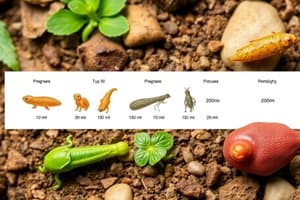Podcast
Questions and Answers
جاندارن جي درجه بندي ڪرڻ جو بنيادي مقصد ڇا آهي؟
جاندارن جي درجه بندي ڪرڻ جو بنيادي مقصد ڇا آهي؟
- جاندارن کي سندن شڪل جي بنياد تي گروپن ۾ ورهائڻ
- جاندارن کي هڪ ٻئي کان الڳ ڪرڻ
- جاندارن جي وسيع تنوع کي منظم ڪرڻ (correct)
- جاندارن جي بي ترتيبي کي وڌائڻ
هومو لوگس (Homologous) جوڙجڪون ڇا ظاهر ڪن ٿيون؟
هومو لوگس (Homologous) جوڙجڪون ڇا ظاهر ڪن ٿيون؟
- جاندارن جي مختلف ابن ڏاڏن جي جوڙجڪ
- جوڙجڪ جي ڪمن ۾ فرق
- جاندارن جي هڪ جهڙين ابن ڏاڏن جي جوڙجڪ (correct)
- جوڙجڪ جي بناوت ۾ فرق
ٽيڪسانومڪ هيرارڪي ۾ "ڪلاس" ڪهڙي ٽيڪسانومڪ ليول جي وچ ۾ اچي ٿو؟
ٽيڪسانومڪ هيرارڪي ۾ "ڪلاس" ڪهڙي ٽيڪسانومڪ ليول جي وچ ۾ اچي ٿو؟
- فائلم ۽ آرڊر (correct)
- آرڊر ۽ اسپيشيز
- ڪنگڊم ۽ فائلم
- فيملي ۽ جينس
درجه بندي سسٽم ۾ بنيادي يونٽ کي ڇا چئبو آهي؟
درجه بندي سسٽم ۾ بنيادي يونٽ کي ڇا چئبو آهي؟
ارسطو پاران جاندارن جي درجه بندي ڪهڙي بنياد تي ڪئي وئي هئي؟
ارسطو پاران جاندارن جي درجه بندي ڪهڙي بنياد تي ڪئي وئي هئي؟
ڪارل لينيئس (Carl Linnaeus) جو سائنس ۾ ڪهڙو اهم ڪردار آهي؟
ڪارل لينيئس (Carl Linnaeus) جو سائنس ۾ ڪهڙو اهم ڪردار آهي؟
ٻن بادشاهن واري درجه بندي ۾ جاندارن کي ڪهڙن ٻن قسمن ۾ ورهائيندا هئا؟
ٻن بادشاهن واري درجه بندي ۾ جاندارن کي ڪهڙن ٻن قسمن ۾ ورهائيندا هئا؟
Flashcards
بايو ډائيورسٽي (Biodiversity)
بايو ډائيورسٽي (Biodiversity)
ڌرتيءَ تي زندگيءَ جي قسمون ۽ انهن جون مختلف تبديليون، جهڙوڪ جين، جاندار ۽ ماحولياتي سطح تي.
بايو ډائيورسٽي جو اهميت
بايو ډائيورسٽي جو اهميت
بايو ډائيورسٽي هڪ اهم ڪردار ادا ڪري ٿو، جهڙوڪ کاڌو، دوائون ۽ ٻيا شين لاءِ قيمتي وسائل فراهم ڪرڻ ۾. اهو ماحولياتي نظام جي استحڪام ۽ لچڪداري کي وڌائي ٿو. فطرت جي خوبصورتي ۽ تفريحي قدر ۾ حصو وٺي ٿو. ۽ زندگيءَ جون مختلف صورتون سپورٽ ڪري ٿو.
طبقه بندي (Classification)
طبقه بندي (Classification)
زندگيءَ جي مختلف قسمون ۽ انهن جي ورڇ کي منظم ڪرڻ لاءِ هڪ نظام. جاندارن کي مشترڪ خاصيتن ۽ ترقي واري تعلقات جي بنياد تي گروهه ۾ ورهايو ويندو آهي.
همولوگس ڍانچا (Homologous Structures)
همولوگس ڍانچا (Homologous Structures)
Signup and view all the flashcards
اينالوگس ڍانچا (Analogous Structures)
اينالوگس ڍانچا (Analogous Structures)
Signup and view all the flashcards
طبقه بنديءَ جي هيرارڪي (Taxonomic Hierarchy)
طبقه بنديءَ جي هيرارڪي (Taxonomic Hierarchy)
Signup and view all the flashcards
ذات (Species)
ذات (Species)
Signup and view all the flashcards
ٻن جاندارن جي سادي طبقه بندي
ٻن جاندارن جي سادي طبقه بندي
Signup and view all the flashcards
Study Notes
Biodiversity (حياتياتي فرق)
- Biodiversity is the variety of life on Earth.
- It includes all types of organisms, from bacteria to plants and animals.
- Biodiversity is important for many reasons, including providing food, medicine, and other resources.
- It also helps maintain a healthy environment.
Aims and Principles of Classification (درجي بندي جا اصول و مقصد)
- Classification is important to understand the diversity of life.
- Scientists categorize different organisms based on various features.
- Classification groups similar organisms together in different ranks (Kingdoms, Phyla, Classes, Orders, Families, Genera, and Species).
- Features like structure, evolutionary relationships, and chemical compositions are considered.
Principles of Classification
- Organisms are sometimes classified based on similar structures and functions, known as homologous structures.
- Structures with different underlying structures, evolving from completely different original structures, but serving similar functions, are called analogous structures.
- Sometimes, classifying organisms based on their physical similarities might be difficult, so scientists investigate their cellular, genetic and chemical features.
Taxonomic Hierarchy (جنس يا صنف بندي جي درجي بندي)
- Taxonomic hierarchy is a system of classifying organisms based on shared characteristics.
- Organisms are grouped into increasingly specific categories: Kingdom, Phylum, Class, Order, Family, Genus, and Species.
- Each category contains more specific groups.
Units of Classification (درجي بندي جا ايكا)
- The basic unit of classification is the species.
- Related species are grouped into genera.
- Related genera are grouped into families.
- Classification progressively broadens from species to kingdoms.
Simple Classification of Two Organisms (بن جاندارن جي سادي درجي بندي)
- A table is provided showing the classification of humans and plants.
- Humans belong to the kingdom Animalia, phylum Chordata, class Mammalia, order Primates, family Hominidae, genus Homo, and species sapiens.
- Plants belong to the kingdom Plantae, phylum Tracheophyta.
History of Classification (درجي بندي جي تاريخ)
- Aristotle is considered the founder of early biological classification.
- Carl Linnaeus established a more systematic approach to biological classification.
- Early classification systems grouped organisms into plants and animals.
- Modern systems use detailed information to organize organisms into various classifications.
Two Kingdom Classification (بن كنگدمس جي درجي بندي)
- A past system of classifying organisms into two kingdoms: animals and plants.
- Organisms with cell walls were placed in the plant kingdom.
- Organisms without cell walls were classified as animals.
Studying That Suits You
Use AI to generate personalized quizzes and flashcards to suit your learning preferences.
Description
حياتياتي فرق ۽ درجي بندي جا اصول جي سمجهاڻي. هي آزمائش مختلف جاندارن جي نوعيت ۽ تنظيم جي بنياد تي تصنيف جي اصولن کي سمجھڻ ۾ مددگار ثابت ٿيندي. جاندارن جي خصوصيتن ۽ ان جي اهميت کي سمجهڻ لاءِ مناسب وسائل فراهم ڪري ٿي.




